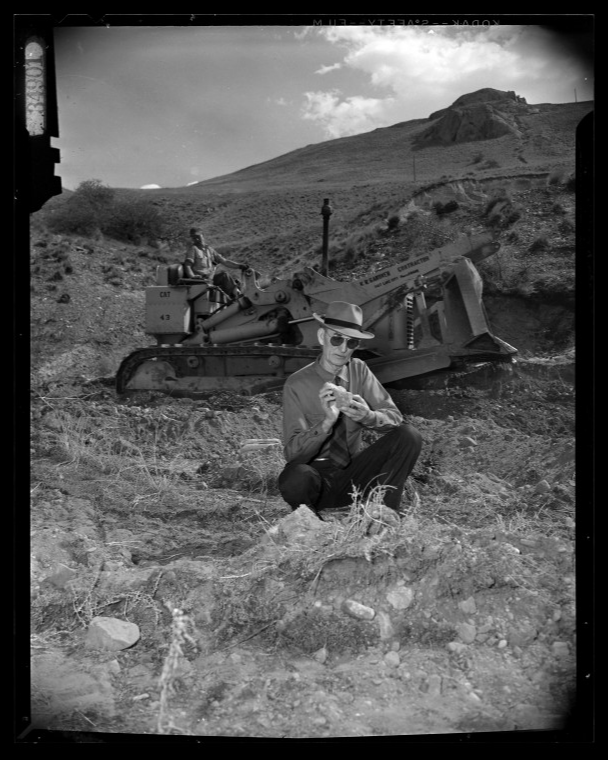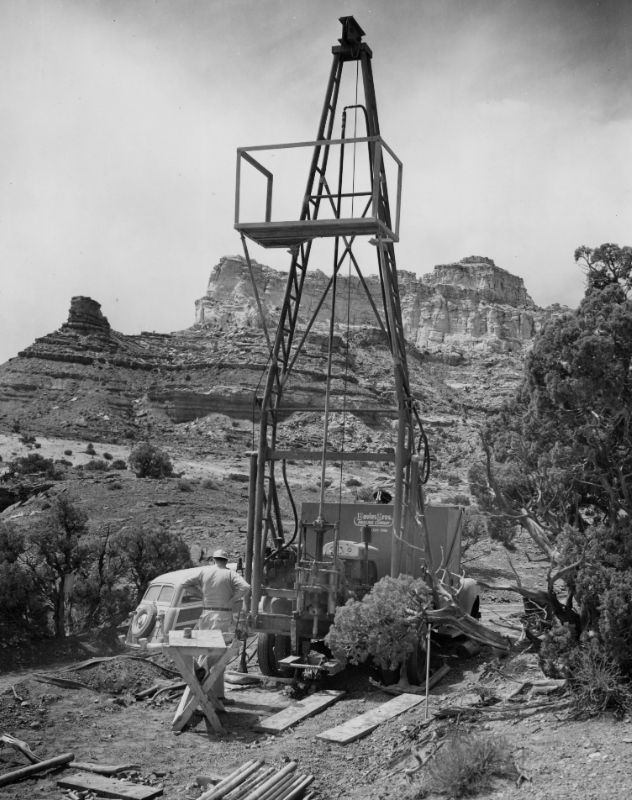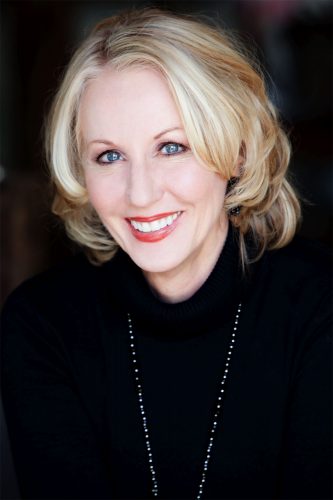Date: April 11, 2022 (Season 4, Episode 12: 55 min. & 40 sec. long). Click here for the BuzzSprout version of this Speak Your Piece episode. The above cropped photograph is of onlookers watching a nuclear detonation blast from the Nevada Test Site. Photo courtesy of the “Downwinders of Utah Archive,” J. Willard Marriott Library, University of Utah. Are you interested in other episodes of Speak Your Piece? This episode was co-produced by Brad Westwood and Chelsey Zamir, with help (sound engineering and postproduction editing) from Jason Powers from the Utah State Library Recording Studio.
This SYP episode is an interview with Mary Dickson, a Downwinder and thyroid cancer survivor, with SYP host Brad Westwood. The episode details Dickson’s personal history and her research regarding the implications of America’s nuclear testing. This captivating and devastating story outlines the historical intersections between Utah, the Intermountain West, and the US’s nuclear government testing, mostly done at the Nevada Test Site (300 miles from SLC), during and after America’s Cold War (1947-1991). Dickson’s story is both local and personal history combined with journalistic writing and investigation.
Podcast Content:
Dickson explains the historical context of the western USA during the era of the Cold War. A nation on edge due to the “Red Scare,” the USA rushed to win a nuclear arms race after Russia announced it has the technology necessary to build its own nuclear capabilities. Wanting to build a nuclear arsenal in response, the USA sought out a permanent bomb test site, finally landing on Utah’s neighbor, Nevada (the Las Vegas Bombing and Gunnery Range), where the Nevada Test Site would come to be. This location was a choice of convenience partly due to the sparse population across the interior west, mixed with the rapid deployment and low costs.
Starting in 1951 to 1962, nearly 100 atmospheric nuclear tests were conducted, some of these bombs even more powerful than the bombs that leveled Hiroshima and Nagasaki, Japan. Health claims from the surrounding population started to pile up including miscarriages and other largely unexplained ailments. The US government then decided to move these tests underground, where testing was conducted until 1992.

Map by researcher Richard Miller based on US Atomic Energy Commission (AEC) records on radiation dispersal. Includes areas crossed by two or more clouds from atmospheric nuclear testing based in Nevada, circa 1951 to 1962. Photo courtesy of “Is Your State on This Map?” Downwind, April 29, 2015.
In an attempt to tamp down concerns, the US government released a statement: these blasts aren’t harmful and, in fact, so safe that people were encouraged to watch the blasts. Behind the scenes, the actual story was kept a secret for nearly forty years. Overall, throughout the eleven years of testing, as Dickson noted, about 160 million Americans suffered the consequences, knowingly or unknowingly becoming “Downwinders,” what Dickson defines as one who has been exposed, and/or lived downwind from the nuclear tests and became ill from the radiation.
Singleton, C.L. (Uranium Hunter)-Shot 1. Photograph taken by the Salt Lake Tribune Staff, March 26. 1956. Photograph courtesy of the Utah State Historical Society.

It wasn’t only the nuclear testing that harmed Americans. With the demand for nuclear bombs came the demand for uranium to build the weapons. Mining of uranium became incredibly attractive for many as it was good, stable work. Uranium mining escalated at a quick pace with nearly 1,380 mines and was located primarily on native lands in Southeastern Utah. Unbeknownst to the mine workers who were given hardly any protective gear, nor knowledge of the health effects, many also suffered health consequences. Many of Utah’s native peoples are still dealing with the health issues, specifically in the Navajo Nation, where mining land remains contaminated.

Uranium prospecting at Temple Mountain, San Rafael Swell, Emery County, Utah; Hal Rummel photographer. Photograph courtesy of the Classified Photograph Collection, Utah State Historical Society.
Dickson describes her youth as an idyllic time period where she was raised in the Canyon Rim area of Salt Lake City. It was a time of little to no concern for Dickson and her family, and she had no idea that there was a “silent poison threading its way through their bodies.” When Dickson was in her late 20s, she was diagnosed with thyroid cancer and had her thyroid removed. This episode includes Dickson’s personal interactions with the history of nuclear fallout.
Dickson describes her youth with little to no idea of the “silent poison threading its way through their bodies.”
Dickson concludes that many people today still do not fully understand the fallout from America’s nuclear testing. The knowledge of how widespread the exposure really was is still not widely known. After her own connection as a Downwinder, Dickson started interviewing and befriending many other Downwinders. She’s also worked with many community members to advocate for the passage of the US congress bill that will expand Radiation Exposure Compensation Act (bills S.2798 and H.R.5338). After several years of advocacy work, Dickson compiled a series of monologues that consisted of interviews from fellow Downwinders and meeting minutes from the Atomic Energy Commission into a playwright titled “Exposed” which was picked up by Plan B Theater Company and continues as stage readings to this day.
Bio: Mary Dickson is a former KUED TV creative director (now retired) and is the host of Contact with Mary Dickson on PBS Utah. She is an award-winning writer and playwright for “Exposed,” and is an internationally recognized advocate for survivors of nuclear weapon testing.

Additional Resources & Reading:
- Vegas Atomic Museum: Home – The Atomic Museum and the NTSHF – Las Vegas, NV.
- Dickson, Mary. “What I Know About Human Life as a Nuclear Downwinder.” Common Dreams, June 17, 2022, Opinion | What I Know About Human Life as a Nuclear Downwinder | Mary Dickson (commondreams.org).
- The “Downwinders of Utah Archive” presents an in-depth study of the nuclear detonations, radioactive fallout, and events, which have resulted in devastating effects for Utah’s “Downwinder” population: https://lib.utah.edu/services/geospatial/downwinders/
- Regarding history of atomic bomb testing and its effects, see: (1) Heller, Bill. A Good Day Has No Rain (Whitston Publishing Co Inc., 2005); (2) blog authored by Sarah Alisabeth Fox, Downwind, Blog — DOWNWIND (downwindhistory.com); (3) Fox, Sarah Alisabeth, Downwind: A People’s History of the Nuclear West (Bison Books, 2014) and (4) Anderson, Robert & Bell, Marissa & Charron, Claude-Yves & Donaghy, Greg & Fox, Sarah & Freeman, et. al., “Hiding in Plain Sight: Uncovering Nuclear Histories.” 10.21810/sfu library.93, (PDF) Hiding in Plain Sight: Uncovering Nuclear Histories (researchgate.net).
- Regarding the history of the Red Scare and material culture effects, see Tom Vanderbilt, Survival City, Adventures Among the Ruins of Atomic America (Princeton Architectural Press, 2002).
- Comprehensive Nuclear-Test-Ban Treaty (CTBT) Preparatory Commission’s website: Homepage | CTBTO.
- Lincoln, Ivan M. “Surviving downwind – Mary Dickson’s play blasts nuclear testing.” Deseret News, October 12, 2007, Surviving downwind Mary Dickson’s play blasts nuclear testing – Deseret News.
- Summary and further information for H.R.5338 – Radiation Exposure Compensation Act Amendments of 2021: H.R.5338 – 117th Congress (2021-2022): Radiation Exposure Compensation Act Amendments of 2021 | Congress.gov | Library of Congress
Do you have a question or comment, or a proposed guest for “Speak Your Piece?” Write us at “ask a historian” – [email protected]

